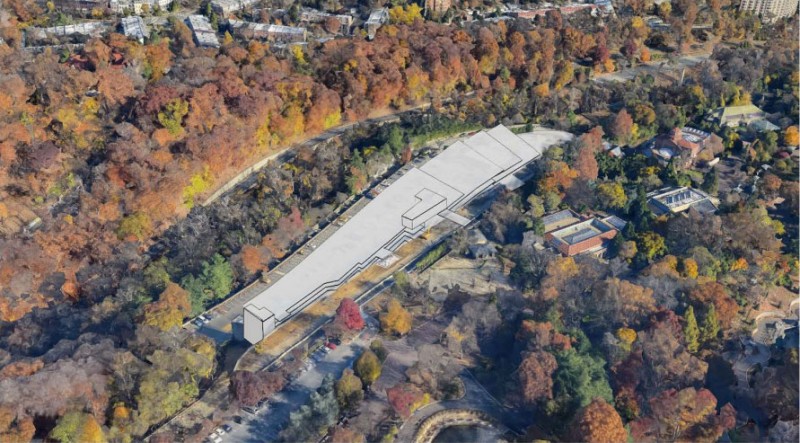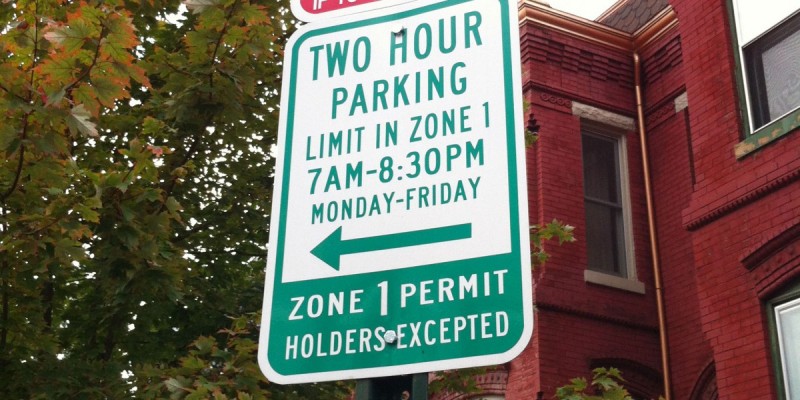The National Zoo says visitors aren’t riding Metro so it needs more parking

National Zoo entrance by Dorothy licensed under Creative Commons.
We first published this post about the National Zoo's plans to add more than 1,000 parking spaces on September 22, 2017. This week, the Zoo will be presenting plans to add fences and cut the number of pedestrian entrances from 13 to three. The submission also talks about future plans to add security checkpoints at the three entrances. Read our post and petition against these measures, which we call “security theater.” This post from last year has more detail about the garage issue.
The National Zoo wants to build a five-level parking garage in place of one of its parking lots. Good idea or bad?
The zoo is accessible by Metro at Woodley Park and Cleveland Park (they're actually about equidistant, despite the word “Zoo” being attached to Woodley Park). It's also reachable by buses, Capital Bikeshare, the Rock Creek bike trail, walking, and driving. But the zoo says fewer people are taking transit and more are driving, so it needs more parking.
In a 2008 master plan, the Smithsonian proposed having 1,620 parking spaces across the zoo property. But the National Capital Planning Commission (NCPC) only allowed 1,285 spots in the plan. To its credit, NCPC has been a strong force pushing federal agencies not to build too much parking, ensuring they don't spend as many taxpayer dollars subsidizing driving to the detriment of walking, biking, and transit. (For example, in 2015, NCPC successfully pushed the National Institutes of Health to scale back a plan to add a lot of parking at its campus right at Medical Center Metro.)
Now, the zoo is asking NCPC to raise the ceiling to 1,451 spaces including the new garage.
Concept drawing of the garage. 
Metro service drops, and other reasons people may be driving
Sadly, Metro's maintenance woes likely are driving some of this effect. On weekends, when the greatest number of families want to go to the zoo, Metro is quite infrequent. SafeTrack made that worse last year, but even without it, WMATA needs to have more maintenance shutdowns and has cut regular service levels.
Michael Neibauer at the Washington Business Journal wrote that despite the presence of a Metro station within walking distance of the main Connecticut Avenue NW zoo entrance, more visitors drove to the zoo in 2016 than in any of the previous five years. According to a transportation study, Metrorail and bus usage fell to 29 percent during the study period from 47 percent in 2015 and 35 percent in 2014.
“The Smithsonian doesn't know why Metro ridership to the zoo is down,” Neibauer continues, “but it suggests a combination of the transit system's SafeTrack maintenance surge, weather, and 'major crimes on the Red Line' may be at least partly to blame.”
Unfortunately, while I hate to say it, getting to the zoo by transit with small children also quite a hassle. The nearby stations at Woodley Park and Cleveland Park aren't all THAT close (0.43 miles from the Woodley escalator, 0.35 miles from the elevator, and 0.45 miles from the Cleveland Park escalator). The Woodley elevator is very crowded and slow with all the people with strollers or disabilities who have to use it, and with those who ride it to save the extra walk from the escalator.
Tracy Loh wrote, “My kid is tiny but insists on walking everywhere herself. To increase her trip distance I got her a scooter, and I'm not hauling that thing up and down the Metro and then having her scoot half a mile before we even get to the zoo. That is a recipe for not seeing lions.”
Plus, once you get to the Connecticut Avenue entrance, you're just at one end of a long zoo walk. My daughter's favorite part of the zoo is the carousel, which is at the bottom (Harvard Street end) of the zoo path.
The zoo does run a shuttle bus between the upper and lower ends. According to page 72 of the NCPC submission, the zoo is considering extending its shuttle bus to Cleveland Park Metro per a DDOT recommendation.
Other ways to help people get to the zoo
Metro or driving don't have to be the only options. Besides the shuttle to Cleveland Park, the presentation says the zoo has talked to WMATA about adding bus stops in the park and discussed with DDOT extending the Woodley Park-Adams Morgan-McPherson Square Circulator to the zoo. (That idea is not in DDOT's Circulator plan though, and the Circulator is not likely to be able to add service anytime soon with its maintenance challenges and lack of enough buses).
There's more to do for bicycle access too. One contributor, who couldn't speak on the record, talked about a recent bike trip where they entered on the Mt. Pleasant side. There were no bike racks so they secured the bikes to railings in a parking lot, worrying they'd be removed. When leaving, they didn't see any signs to the Rock Creek Trail and got stuck behind some fences, then in some parking lots, before finding it.
Bicycling to the zoo isn't going to be a good option for many of the families who go there. Nonetheless, it is right on a major trail and more people may bike if that connection were better.
People park in the neighborhood
One parking problem, Smithsonian planners say, is patrons trying to park in nearby Lanier Heights or Mt. Pleasant and then walk to the zoo. They argue the new parking “would significantly reduce the likelihood of zoo visitors searching for off-site parking in the adjacent neighborhoods on approximately 15 additional Saturdays or Sundays compared to the previously approved parking total.”
That might be true of zoo members who get free parking (more on that later), but for casual visitors, street parking has a huge advantage over zoo parking: money. Parking costs $22 for the day, versus zero on city streets.
Image by Wayan Vota licensed under Creative Commons.
DDOT could fix this problem by adding a pay-by-phone requirement for all non-Zone 1 (or ideally, using a smaller zone) parkers. Instead of two hours free weekdays (or Zone 1 only weekdays) and unlimited parking weekends, require anyone without the resident sticker to pay a few dollars an hour using the pay-by-phone system. To let residents have visitors without them needing to pay so much, print up one-day coupons and give some to immediate residents.
Some people might still park on the street if it's cheaper than the zoo, but DDOT can use the price to keep the parking from getting totally filled up. The neighborhood is still a longer walk than the zoo lot, so that's a deterrent.
The idea that if people are parking elsewhere you just build so much parking to meet even the highest levels of demand is bad policy. Pricing, carefully designed, is the right policy.
Who gets free parking?
Some of the spaces, according to the presentation, are for employees and visitors. As part of its recommendations to mitigate the effects of more parking, DDOT recommended the Smithsonian “eliminate free parking for zoo employees (parking for volunteers, official SI vehicles and official guests would remain free; volunteer parking would not be reserved).”
The presentation (page 72-73) says:
The Smithsonian is working on developing a parking policy slated for implementation in conjuction with the new Parking Garage project. An [National Zoological Park] Employee parking committee was formed and is working towards a policy and implementation. We will charge for parking at similar rates to what SI charges downtown and there will be a points system for eligibility based on seniority, vehicle fuel type and carpooling, combined with consideration of special needs.
Sounds good. It's not clear why volunteer parking should remain free, but that's probably minor.
Free parking also is available to anyone who joins as a zoo member at $80 a year or more. Any policy that gives people unlimited free parking induces more driving. In 2011, the Smithsonian's Inspector General suggested restricting the parking benefit such as giving members a fixed number of free parking days instead of unlimited. Or, perhaps just as $60 members get a 60% discount, $80 members could get a steeper but not full discount. That way, there's always some economic value of choosing not to drive for an individual trip.
Another factor: At least some people park at the zoo on weekdays not to see animals, but as commuter parking to get to a job.
The presentation says the Smithsonian did explore – but rejected – ideas like offering overflow parking at nearby hotels. Unfortunately, those garages are heavily used on weekends and charge even more for parking (the Marriott Wardman Park charges $45 a day; the Omni Shoreham, $49 for 2 hours or more.) Large office buildings with garages tend to have space on weekends, but Woodley Park isn't an office district.
What else do you think the zoo could do to help with access? What do you think of the parking garage plan?
Correction: This post previously stated that the National Zoo would be presenting plans to add parking this week. The Zoo will be presenting plans about adding fencing and cutting the number of pedestrian entrances, but not about parking.
